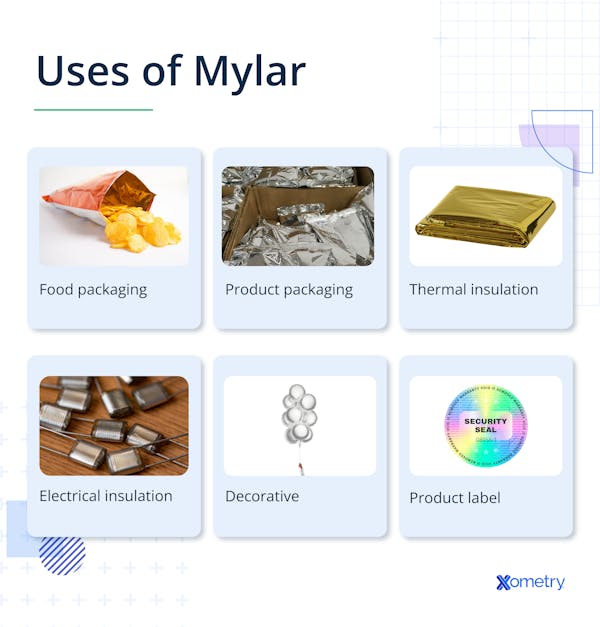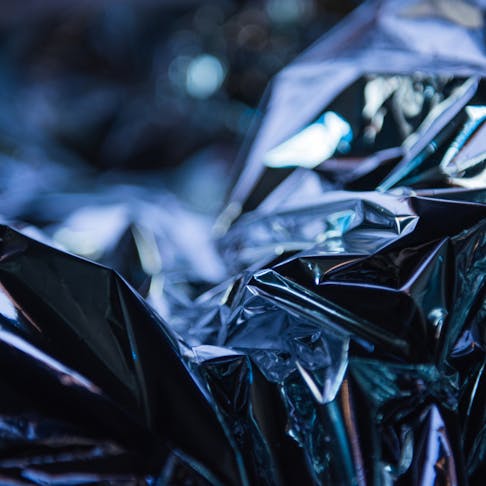Mylar® is a polyester film that is widely used due to its exceptional mechanical and chemical properties. It is so popular that it has become nearly synonymous with any plastic film. Mylar is used in numerous applications, from helium-filled balloons and food packaging to electrical and thermal insulators. Mylar was developed by DuPont in the early 1950s, building on PET research originally conducted by Imperial Chemical Industries (ICI). It is a registered trademark of DuPont Teijin Films. This article will define Mylar film, describe how it’s made, discuss its properties, and give examples of Mylar applications.
What Is Mylar?
Mylar® is a polyester film recognized for its strength, durability, and resistance to heat and chemicals. Its broad utility has made it nearly synonymous with plastic film across industries. Developed in the 1950s by DuPont, building on research by ICI, it is now a trademark of DuPont Teijin Films.
What Is Mylar Made of?
Mylar is made from polyethylene terephthalate (PET). The material is also known by its scientific name BoPET (biaxially-oriented polyethylene terephthalate). Here's how Mylar is fabricated:
- PET polymer is melted and extruded onto a chilled drum roller to form a film.
- The film is stretched biaxially in the machine (or feed) direction and the transverse (width) direction. This is achieved by feeding the film over a series of rollers and then into a stenter frame, where it is stretched in the transverse direction. This stretching process orients the PET molecules to enhance the film’s mechanical properties.
- The film is heat-set at temperatures around 160-220°C (320-428°F) to improve dimensional stability and prevent shrinkage during subsequent use.
At the end of the fabrication process, the Mylar film is so smooth that it tends to stick to itself. Mylar may be coated with silicon dioxide (SiO₂) to improve its barrier performance and surface hardness. To reduce blocking (stickiness), slip agents or anti-block coatings are typically used. Additionally, Mylar can be coated with evaporated gold, aluminum, or other metal using a physical vapor deposition process to reduce transparency, increase reflectivity, and make it less permeable to gases.
What Are the Properties of Mylar?
The versatility of Mylar, and its ability to retain its properties across a wide temperature range (-94°F to 302°F or -70°C to 150°C) make it ideal for a variety of applications across different industries. It can tolerate more extreme limits (from -418°F to 392°F or -250°C to 200°C), although its strength and flexibility may diminish outside typical use conditions.
The properties of Mylar are listed below:
- Tensile strength typically ranges from 20 to 30 ksi, depending on the film grade and thickness.
- It is dimensionally stable over a wide temperature range.
- It is chemically inert, resistant to oils, solvents, moisture, and grease.
- It has low permeability and can be used as a barrier against most liquids and gases.
- It has excellent thermal stability and a low thermal expansion coefficient of 1.7 × 10 -5 in/in/°C (9.5 × 10 -6 in/in/°F). This makes the material an excellent thermal insulator.
- Mylar has a volume resistivity in the range of 10¹⁶ to 10¹⁸ ohm·cm and excellent dielectric properties, making it an effective electrical insulator.
- It is reflective. When metal-coated, it reflects heat and light, which can enhance thermal insulation and visual appeal.
- Uncoated Mylar is transparent and transmits 80–90% of visible light in thinner grades. Infrared transmission varies and decreases significantly at longer wavelengths or higher thicknesses. This can be desired for certain applications, such as tags and equipment labels.
What Are the Uses of Mylar?
Mylar performs reliably in various industries due to its mechanical stability and resistance to environmental factors like heat, moisture, and chemicals. Its low permeability makes it great for food packaging, while its electrical properties make it a great electrical insulator.
Some common uses of Mylar are:
- Flexible food packaging, such as yogurt lids, potato chip bags, foil coffee pouches, and candy wrappers
- Product packaging for clothing, books, and other consumer products
- Product labels, stickers, and tags
- Thermal insulation for air ducts, tents, survival blankets, and other temperature-sensitive items
- Electrical insulation for wiring applications
- Decorative balloons, party decor, kites, and other items

Can Mylar Be Used in Laser Cutting?
Yes, Mylar can be cut using a laser. All available Mylar thicknesses are well within the capabilities of standard laser cutters. Its thin profile and moderate thermal degradation temperature (~350°C or 662°F), when compared to other plastics like Delrin®, make it suitable for laser cutting, though proper ventilation is recommended due to fume generation.
What Are the Uses of Mylar in Laser Cutting?
Laser cutting is commonly used for processing Mylar, including with entry-level systems, due to its low thickness and responsiveness to heat. Mylar's durability and flexibility make it the perfect option for many plastic film applications. Its relatively low decomposition temperature makes laser cutting an effective method for shaping Mylar products, though the process generates fumes that require proper ventilation. The primary application of laser-cut Mylar is the fabrication of stencils for craft applications. However, laser-cut Mylar can also be used to create beautifully intricate patterns, shapes, and designs, or to create products such as food packaging.
For more information, see our guide on Laser Cutting.
How Is Mylar Used In Stencils?
Mylar is often used to produce stencils for craft and hobby applications. Laser cutting is preferred for stencils because it provides clean, accurate cuts. Other materials like cardboard can be laser cut, but lack the same precision and durability. Additionally, these materials lack longevity and can easily be deformed.
How To Use Mylar for Making Stencils
To laser cut Mylar stencils, use low power and high speed to minimize melting and edge charring. Proper ventilation is essential due to fumes released during decomposition.
The steps below describe in detail how to use Mylar for making stencils by laser cutting:
- Place a backer board, such as cardboard or cardstock, underneath the Mylar sheet. This will protect the laser work table or the surface directly underneath the laser from being damaged by the laser.
- Secure the sheet to the backer board using a glue stick, spray adhesive, or tape. Then, secure the backer board to the work table using tape or a clamp. This will prevent the sheet from shifting during laser cutting. It will also allow the finished stencil to be easily removed since the unwanted portions will stick to the backer board.
- Configure the laser system for cutting Mylar material. Cutting speeds should be fast enough to prevent excessive heat buildup and melting. However, the thickness of the sheet determines the power that must be used.
Table 1 below shows recommended power settings and speeds for cutting various thicknesses of Mylar:
| Sheet Thickness | Laser Power | Cutting Speed |
|---|---|---|
Sheet Thickness 0.10 mm | Laser Power 7 W | Cutting Speed 150 mm/s |
Sheet Thickness 0.20 mm | Laser Power 8 W | Cutting Speed 130-150 mm/s |
Sheet Thickness 0.25 mm | Laser Power 9 W | Cutting Speed 120-140 mm/s |
Frequently Asked Questions About Mylar
What Is the Ideal Mylar Thickness for Laser Cutting Stencils?
The ideal Mylar thickness for laser cutting stencils is typically 0.1 to 0.2 mm (4 to 8 mil), depending on the required flexibility and detail. Thicker sheets may be harder to cut cleanly or to use for precise stenciling. While all Mylar can be laser cut easily with any laser system, thicker sheets are not ideal for stencils. This is because using stencils for drawing and art can be difficult if the stencil is too thick.
Is Mylar Expensive?
No, Mylar is not expensive. Mylar can be purchased in packs of individual sheets, full rolls, or as bags. Rolls as large as 4 ft x 100 ft can be purchased for as little as about $50. A roll this large will furnish enough material to complete numerous projects.
Is Mylar a Reflective Material?
Yes, Mylar becomes highly reflective when coated with a thin layer of metal, such as aluminum. Uncoated Mylar is transparent or slightly hazy, depending on thickness, and does not reflect light in the same way.
Is Mylar Chemically Reactive?
No, Mylar is chemically inert. It does not react with materials like oils and solvents. The material’s chemical inertness also makes it very easy to clean. Mylar is not only chemically unreactive, but it is also impermeable. This makes it a great barrier against gases and odors.
Summary
This article presented Mylar, explained it, and discussed its various uses across different processes. To learn more about Mylar, contact a Xometry representative.
Xometry provides a wide range of manufacturing capabilities and other value-added services for all of your prototyping and production needs. Visit our website to learn more or to request a free, no-obligation quote.
Copyright and Trademark Notices
- Mylar® and Melinex® are trademarks of DuPont Teijin Films.
- Hostaphan® is a trademark of Mitsubishi Chemical Group.
Disclaimer
The content appearing on this webpage is for informational purposes only. Xometry makes no representation or warranty of any kind, be it expressed or implied, as to the accuracy, completeness, or validity of the information. Any performance parameters, geometric tolerances, specific design features, quality and types of materials, or processes should not be inferred to represent what will be delivered by third-party suppliers or manufacturers through Xometry’s network. Buyers seeking quotes for parts are responsible for defining the specific requirements for those parts. Please refer to our terms and conditions for more information.


